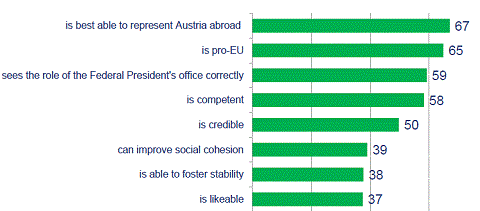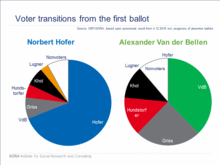
Die Seite www.foresight.at ist gerade im Aufbau. Diese Seite (sora.at) wird nicht mehr gewartet und im Frühjahr 2024 vom Netz genommen.
Elections of the Federal President
of the Republic of Austria 2016: re-vote

- Voting motives for Van der Bellen
Presidential elections were held in Austria on April 24, 2016, with a second round run-off on May 22, 2016. However, the results of the run-off were overturned by the Constitutional Court and a re-vote was scheduled for Sunday, December 4 2016.
The ORF/SORA/ISA election day survey among 1.218 eligible voters shows which motives moved voters in the re-vote.
Van der Bellen convinced with pro-European attitude and representation of Austria abroad
In the ORF/SORA/ISA election day survey, voters were asked which were the most important motives for their voting decision.
Most important motives for Alexander Van der Bellen was the view that he would be better able to represent Austria abroad (67% “very important” motive) as well as his pro-European attitude (65%), his more traditional view of the President’s role (59%) and his competency (58%).
42% of the voters of Van der Bellen said that they voted for him to prevent Norbert Hofer from winning. 54% saw this as a fundamental decision about Austria’s future.
Hofer-campaign scored with anti-establishment message, competency and bringing change
Most voters of Norbert Hofer (51%) decided for their candidate because they wanted him for President and not because they wanted to prevent a victory of Van der Bellen.
Most important motives for Hofer-voters were that he „understands the worries of people like me“ (55% very important), his competency (55%), and his opposition to the political establishment (54%). 52% said that they voted for Hofer because he will bring about change in Austria.
Strong backing for democracy and election procedure
A clear majority of 93% the population is confident that this election is carried out properly and votes are counted correctly (66% strongly agree, 27% fairly agree). This high level of trust can be found among all population groups, among voters as well as non-voters, supporters of Hofer as well as Van der Bellen.
Eight out of ten respondents (80%) say that they would accept the other candidate as President if he wins (strongly / fairly agree). This is true for 77% of Hofer and 78% of Van der Bellen voters
Who voted for whom? Voting behavior by socio-demographic groups
The ORF/SORA/ISA election reveals the major differences in voting behaviour.
Hofer spoke to pessimists, Van der Bellen to optimists
One of the strongest predictors for voting choice in this election are pessimistic versus optimistic expectations about the future:
Among those perceiving a negative development of the quality of life in Austria, Hofer receives 70% of the vote, that is 40 percentage points more than Van der Bellen. Conversely, Van der Bellen was rather supported by optimists (73%) and those expecting no changes in the quality of life (59%).
As the election day survey shows, the turnout among optimists was clearly higher than among pessimists, i.e. the Hofer-campaign failed to mobilise this population group.
How voters of social-democratic and people’s party decided
Looking at party preferences, the election day survey shows that 90% of those who would currently vote for the social-democrats (SPÖ) supported Alexander Van der Bellen.
Among those who would currently vote for the people’s party (ÖVP), on the other hand, 45% supported Hofer and 55% Van der Bellen.
Strong gender differences
Strong gender differences marked already the runoff election in May.
If only women had voted in the runoff, Van der Bellen would have won with 62%, if only men had voted, Norbert Hofer would have received 56%.
Differences by age: Van der Bellen mobilised the young
Alexander Van der Bellen received 58% of the vote among 16-29 year-olds, especially young women voted for him (young men voted rather for Hofer). Among women above 60, he received 62%.
Hofer received his best result (58%) among men aged 30-59.
Voting behaviour by formal education
Austrians with high shool diploma or tertiary education voted rather for Alexander Van der Bellen.
Among Austrians without high school diploma on the other hand, Norbert Hofer was in the lead.
Cities for Van der Bellen, countryside for Hofer
Another cleavage in this election separates the big cities from the countryside: Van der Bellen rather spoke to the densely populated urban areas where he received 61% of the vote. Norbert Hofer, on the other hand, appealed more to rural, sparsely populated areas where he received 53% of the vote.
Voter transition analysis
In May, Alexander Van der Bellen was in the lead with ca. 31.000 votes. In the re-vote, this lead grew to over 300.000 votes. This is due to the following voter dynamics:
- Looking at the direct exchange between the two candidates, Van der Bellen won over 77.000 voters who had supported Hofer in May. On the other hand, only 30.000 votes went from Van der Bellen to Hofer.
- Moreover, Van der Bellen was better able to mobilise voters: 169.000 non-voters from May supported him in this re-vote, while he only lost 25.000 voters who did not go to the polls this time (sum +144.000).
Hofer on the other hand shows a negative exchange with non-voters, i.e. he lost 70.000 of his voters from May who did not vote this time, while he only mobilised 33.000 non-voters from May.
Looking at voter transitions from the first ballot in April 2016, the following trends can be observed:
- Both candidates were able to mobilize almost all of their supporters from the first ballot in April again
- Alexander Van der Bellen mobilized 265.000 non-voters from the first ballot, Norbert Hofer 176.000.
- Supporters of Irmgard Griss mostly voted for Van der Bellen (595.000, i.e 73% of the Griss votes)
- 72% of Hundstorfer-voters decided for Van der Bellen (350.000 votes).
- Sex out of ten (59%) voters of Andreas Khol decided for Van der Bellen in the re-vote, one third (33%) for Norbert Hofer.

